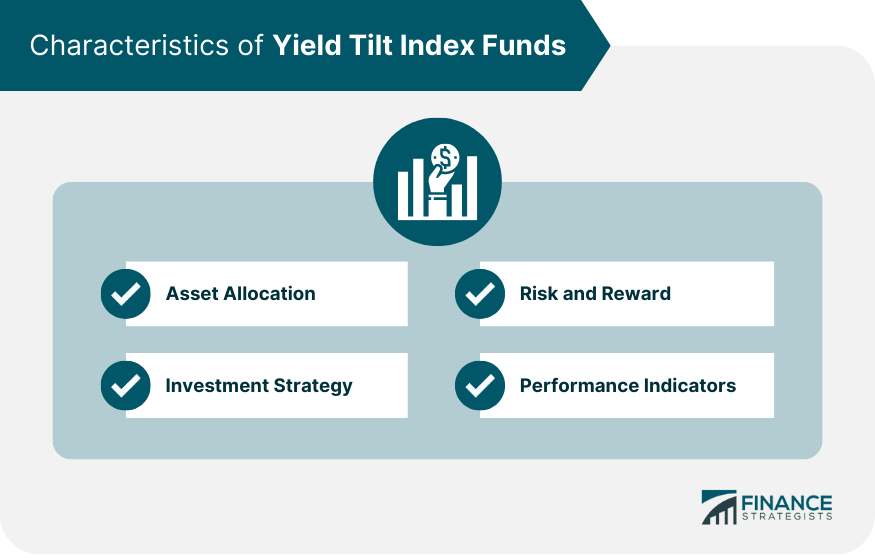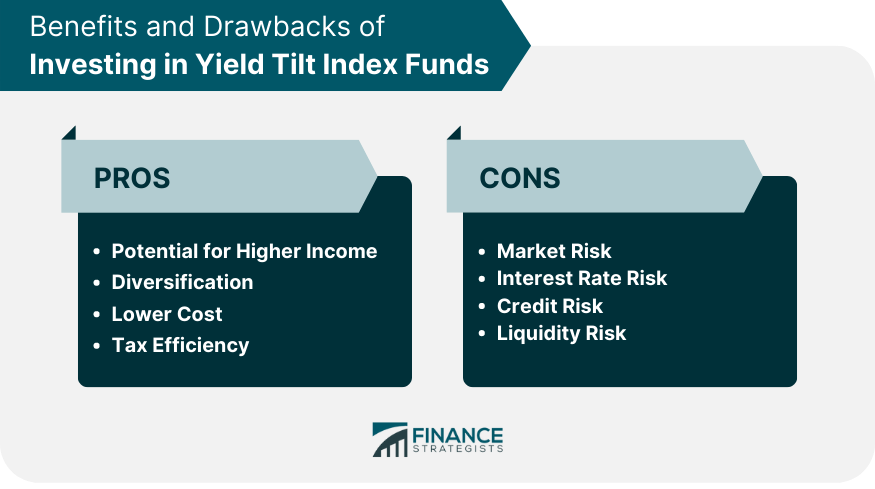Yield Tilt Index Funds, a unique blend of income-based investing and passive fund management, are making their mark in today's investment landscape. The merging of yield-focused strategies with the broad market exposure of index funds presents an intriguing opportunity for investors seeking regular income and market participation. "Yield Tilt" refers to an investment strategy that gives more weight to income-producing assets. This strategy aims to increase the fund's overall yield, providing investors with a higher income stream compared to standard index funds. An index fund is a type of mutual fund or exchange-traded fund (ETF) that aims to replicate the performance of a specific market index. It offers broad market exposure, low operating expenses, and low portfolio turnover. A Yield Tilt Index Fund, therefore, is a fund that replicates a market index but is weighted towards higher-yielding securities. These funds offer an attractive proposition for income-focused investors, blending the cost-efficiency and broad market exposure of index funds with a higher income potential from yield-tilted assets. Yield Tilt Index Funds primarily invest in higher-yielding assets, which may include dividend-paying stocks, high-yield bonds, real estate investment trusts (REITs), and other income-generating securities. These funds implement a passive investment strategy by mirroring a specific index. However, they tilt the portfolio towards securities with higher yields, providing potential for enhanced income. While Yield Tilt Index Funds may offer higher income, they also may bear higher risk. The funds' concentration in high-yielding securities could expose investors to increased market volatility and potential losses. The performance of Yield Tilt Index Funds can be measured through total return, yield, and comparison with the benchmark index. By tilting towards high-yield securities, these funds may deliver higher income compared to standard index funds. Yield Tilt Index Funds offer broad market exposure, which can help diversify an investor's portfolio and reduce risk. As passive funds, Yield Tilt Index Funds typically have lower expense ratios compared to actively managed funds, making them a cost-effective choice for investors. Their passive nature also leads to lower portfolio turnover, which can enhance tax efficiency for investors. Like all investments, Yield Tilt Index Funds are subject to market risk. Their tilt towards high-yield securities could expose investors to increased volatility. Yield Tilt Index Funds may be sensitive to changes in interest rates, particularly if they hold a significant portion of fixed-income securities. If the fund invests in high-yield bonds (also known as junk bonds), there's a risk that the issuer may default on their obligations, leading to potential losses. Some high-yield securities may be less liquid, which could impact the fund's ability to sell these securities quickly and without significant price impact. While both types of funds aim to replicate the performance of a specific index, Yield Tilt Index Funds focus on higher-yielding securities, potentially offering a higher income stream. However, this comes with additional risks not typically associated with standard index funds. Unlike actively managed funds, Yield Tilt Index Funds follow a passive investment strategy, leading to lower costs. While active funds may offer the potential for outperformance, they often come with higher expense ratios and may not consistently outperform their benchmark. While growth funds focus on companies expected to grow at an above-average rate, and value funds target undervalued companies, Yield Tilt Index Funds prioritize securities with high yields. This different focus may make Yield Tilt Index Funds more suitable for income-focused investors. When choosing a Yield Tilt Index Fund, investors should consider factors such as the fund's yield, total return, risk level, expense ratio, and how well it fits with their investment goals and risk tolerance. Investors can buy Yield Tilt Index Funds through brokerage accounts. The purchasing process typically involves setting up an account, depositing funds, selecting the desired Yield Tilt Index Fund, and placing a buy order. While Yield Tilt Index Funds are passively managed, investors should regularly review their holdings to ensure alignment with their investment goals. This may involve rebalancing the portfolio periodically. Yield Tilt Index Funds may be suitable for income-focused investors seeking regular income, broad market exposure, and a cost-effective investment solution. Depending on an investor's goals, Yield Tilt Index Funds could serve as a core portfolio holding or complement other investments to enhance income and diversification. While Yield Tilt Index Funds may enhance income and potential returns, they could also increase portfolio risk due to their focus on high-yield securities. Investors should consider their risk tolerance and investment horizon when incorporating these funds into their portfolios. Yield Tilt Index Funds represent an innovative approach to income-focused investing, cleverly merging the broad market exposure and cost-efficiency of index funds with the potential for higher income through a yield-tilted strategy. This unique blend offers investors a possibility of increased income streams while still maintaining exposure to a variety of market sectors. However, the tilt towards high-yield securities can bring additional risks, including market volatility, interest rate sensitivity, credit risk, and liquidity risk. In conclusion, the suitability of Yield Tilt Index Funds greatly depends on an individual's investment goals, risk tolerance, and market conditions. Despite the potential for higher income, the associated risks must be carefully weighed. Furthermore, investors should remain mindful of evolving economic circumstances, technological advancements, and shifts in investor behavior, which could all influence the future landscape of Yield Tilt Index Fund investing. As with any investment decision, thorough research and due diligence are crucial for success.Yield Tilt Index Fund: Overview
Understanding Yield Tilt Index Funds
Characteristics of Yield Tilt Index Funds
Asset Allocation
Investment Strategy
Risk and Reward
Performance Indicators

Benefits of Investing in Yield Tilt Index Funds
Potential for Higher Income
Diversification
Lower Cost
Tax Efficiency
Drawbacks of Yield Tilt Index Funds
Market Risk
Interest Rate Risk
Credit Risk
Liquidity Risk

Comparison With Other Types of Funds
Yield Tilt Index Fund vs Standard Index Fund
Yield Tilt Index Fund vs Active Funds
Yield Tilt Index Fund vs Growth and Value Funds
How to Invest in Yield Tilt Index Funds
Choosing the Right Fund
Account Setup and Purchasing Process
Ongoing Management and Rebalancing Strategies
Role of Yield Tilt Index Funds in Portfolio Construction
Suitability for Different Types of Investors
Alignment With Various Investment Goals and Strategies
Impact on Portfolio Risk and Return
Final Thoughts
Yield Tilt Index Fund FAQs
A Yield Tilt Index Fund is an investment fund that aims to track the performance of an underlying index that places a greater emphasis on stocks with higher dividend yields. This means that the fund will generally hold a higher proportion of dividend-paying stocks compared to other types of stocks.
A Yield Tilt Index Fund differs from other index funds in that it places a greater emphasis on high-yield dividend stocks. Other index funds may track a broad market index or focus on a specific sector, whereas a Yield Tilt Index Fund focuses on companies with higher dividend yields.
One advantage of investing in a Yield Tilt Index Fund is the potential for higher dividend income. Additionally, as the fund typically holds a diversified portfolio of stocks, it can help reduce overall portfolio risk. Finally, because it is a passively managed fund, it typically has lower fees than actively managed funds.
One risk associated with investing in a Yield Tilt Index Fund is that the fund may underperform the broader market during periods when stocks with low or no dividend yields are outperforming. Additionally, as with any investment in the stock market, there is always the risk of loss of principal.
Before investing in a Yield Tilt Index Fund, it is important to consider your investment goals, risk tolerance, and overall investment strategy. If you are seeking higher dividend income and a lower-risk investment, a Yield Tilt Index Fund may be a suitable investment option. However, if you are seeking higher returns or have a higher risk tolerance, other investment options may be more appropriate. It is recommended to consult with a financial advisor to determine the best investment options for your specific needs.
True Tamplin is a published author, public speaker, CEO of UpDigital, and founder of Finance Strategists.
True is a Certified Educator in Personal Finance (CEPF®), author of The Handy Financial Ratios Guide, a member of the Society for Advancing Business Editing and Writing, contributes to his financial education site, Finance Strategists, and has spoken to various financial communities such as the CFA Institute, as well as university students like his Alma mater, Biola University, where he received a bachelor of science in business and data analytics.
To learn more about True, visit his personal website or view his author profiles on Amazon, Nasdaq and Forbes.











